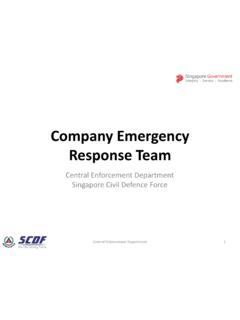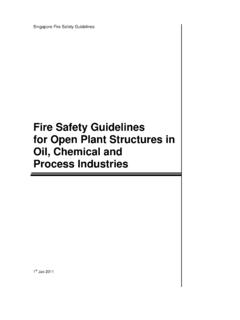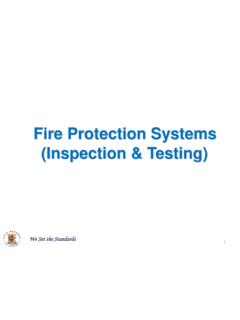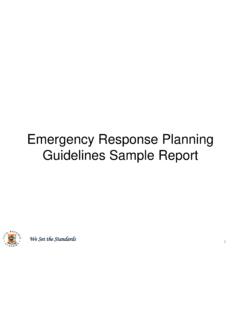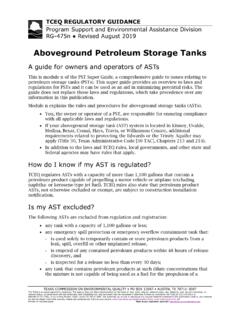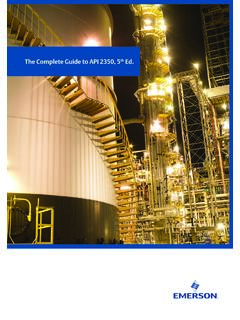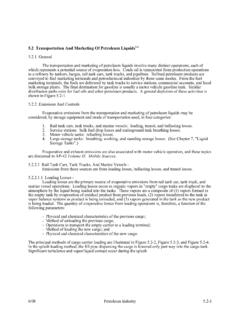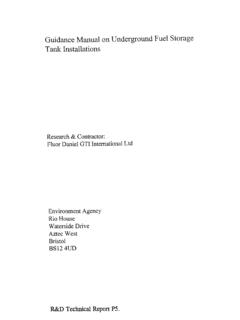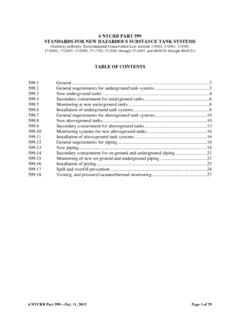Transcription of FIRE SAFETY REQUIREMENTS FOR PETROLEUM SERVICE …
1 J1 Appendix J FIRE SAFETY REQUIREMENTS FOR PETROLEUM SERVICE STATION Appendix to Clause 1. SITING OF PETROLEUM SERVICE STATION Any site chosen should be sufficiently spacious for it to be designed to minimise the risks of any unauthorized person to be at or near the filling stations. ( it must be sited away from normal human traffics and isolated from other buildings entrances and exits). PETROLEUM SERVICE stations shall be sited away from any places of public assembly where there is large number of people, such as town centres, neighbourhood centres, important buildings and key installations.
2 Examples of places of public assembly are shown in Annex A (not exhaustively listed). If the distances from the boundary line of the PETROLEUM SERVICE stations to any residential buildings and places of public assembly are within the following dimensions, a) Residential buildings - 50 meters b) Places of public assembly - 90 meters consultations must be made with FSSD of SCDF. The route for tank vehicles leading to PETROLEUM SERVICE stations should not pass through or be near to the kind of places mentioned in clause SERVICE station shall be stand-alone type and dispensing of petrol shall be restricted to the ground level only (see Annex B).
3 Convenience stores integrated with the PETROLEUM SERVICE station is limited to 300 square meters. Consultation and approval with regards to new PETROLEUM SERVICE station shall be sought from FSSD (URA and NEA) before the actual plan submission with regards to the Self-Regulation Scheme. Licensing REQUIREMENTS must be in accordance to the Fire SAFETY Act, Fire SAFETY ( PETROLEUM & Flammable Materials) Regulations. J2 2 STORAGE AND TANK REQUIREMENTS tanks for all classes of PETROLEUM in a PETROLEUM SERVICE Station shall be installed underground .
4 All underground tanks shall have a water capacity not more than 30kl each. Tank REQUIREMENTS The tank shall be designed, constructed, installed and tested to meet any of the following or other equivalent standards: (i) British Standards (BS 2594): Carbon Steel Welded Horizontal Cylindrical Storage tanks . (ii) Underwriters Laboratories (UL 58): Steel underground tanks for Flammable and Combustible Liquids. (iii) Standards Association of Australia (1962): Steel tanks for the Storage of Flammable and Combustible Liquids. (iv) NFPA 30, Flammable and Combustible Liquids Code. underground tanks and Access Pits All underground tanks shall be in accordance with the following REQUIREMENTS : (a) The road surface above the underground tanks shall be of reinforced concrete of the thickness necessary to support itself and any superimposed loads, but not less than 150mm.
5 (b) The depth from the road surface to the top of the tank shall be not less than 450mm. (c) Each access pit shall be fitted with a cover that is water tight or raised above the level of the surrounding ground to prevent the entry of surface water and of strength sufficient to withstand any superimposed loads. The strength of such a cover shall not be inferior to those of 5mm low carbon steel. Separation from Property Boundaries and Building Foundations The distance of the underground tank to any property boundaries and foundations shall be not less than and 1m respectively (see Annex B). J3 Corrosion Protection Any underground tank and its associated piping shall be protected from corrosion by one or more of the following methods: (a) Protective coating or wrappings (b) Cathodic protection (c) Corrosion-resistant materials of construction Venting Each tank shall incorporate a vent to atmosphere for the vapour space above the liquid.
6 Vent Capacity The size of any vent shall be such that pressure or vacuums resulting from filling, emptying or atmospheric temperature change, will not cause stresses in excess of the maximum design stress for the tank and shall have a minimum internal diameter of 38mm. Vent Piping Any vent piping between the tank vent connection and the discharge point shall comply with the following REQUIREMENTS (see Annex D): (a) The vent pipes shall fall consistently back to the tank at a slope not less than 1 in 40. (b) A vent pipe shall not pass through building foundations but may be embedded in concrete, which is part of other building construction.
7 A vent shall not be run within a cavity wall but may pass through a cavity wall or through masonry which incorporates cavities, provided that it is in a sleeve which will prevent vapour gaining access to the cavities. (c) A vent pipe may be either embedded in a concrete slab or laid in the earth. If the vent pipe is laid in the earth, it shall be: (i) Located not less than 300mm below ground level; (ii) Surrounded by clean washed sand, or provided with equivalent corrosion protection; and (iii) Suitably protected if the area is subject to vehicular traffic. (d) The vent pipe and terminal shall be located or protected so that they are not liable to damage resulting from normal activities.
8 (e) The vent pipe shall be vapour-tight throughout its length. J4 (f) All underground tanks or compartment in a tank shall have a separate individual vent pipe. Vent Outlet Location The discharge point of a vent shall comply with the following REQUIREMENTS : (a) The location, direction and velocity of discharge shall be such that venting vapour will not cause danger to the surrounding. (b) The vent discharge point shall be not less than from any boundary and opening in a building Window, door, ventilator, air conditioner and forced air intake (see Annex B). (c) The vent shall discharge into open air and vent discharge point shall be located not less than 4m above ground level (see Annex D).
9 Vent Terminal (a) The discharge end of a vent shall be protected from the ingress of foreign material by a protective cage of fitting and shall discharge only vertically upward in order to disperse vapours. (b) A vent provision shall be connected to a vapor recovery or collection system, similarly provided for at the filling mentioned in clause Filling Connection The filling connection to a storage tank, which is filled from a tank vehicle, shall incorporate a vapor-tight connection. A cap or cover with lock shall be provided for the filling point. Means shall be provided to prevent accumulation or abnormal discharge of vapor during refilling by having a vapor recovery system.
10 Location of Filling Point The location of the filling point for any storage tank intended to be filled from a tank vehicle shall comply with the following REQUIREMENTS (see Annex B): (a) The length of any hose required to connect a tank vehicle to the filling point shall not exceed 5m (b) The filling point shall be protected from accidental or physical damage. Guardrails or any necessary measures shall be installed to prevent damage by collision. J5 (c) The filling point for any tank containing a Class I, Class II and Class III PETROLEUM shall be in open air at least from any opening into a building and boundary.

